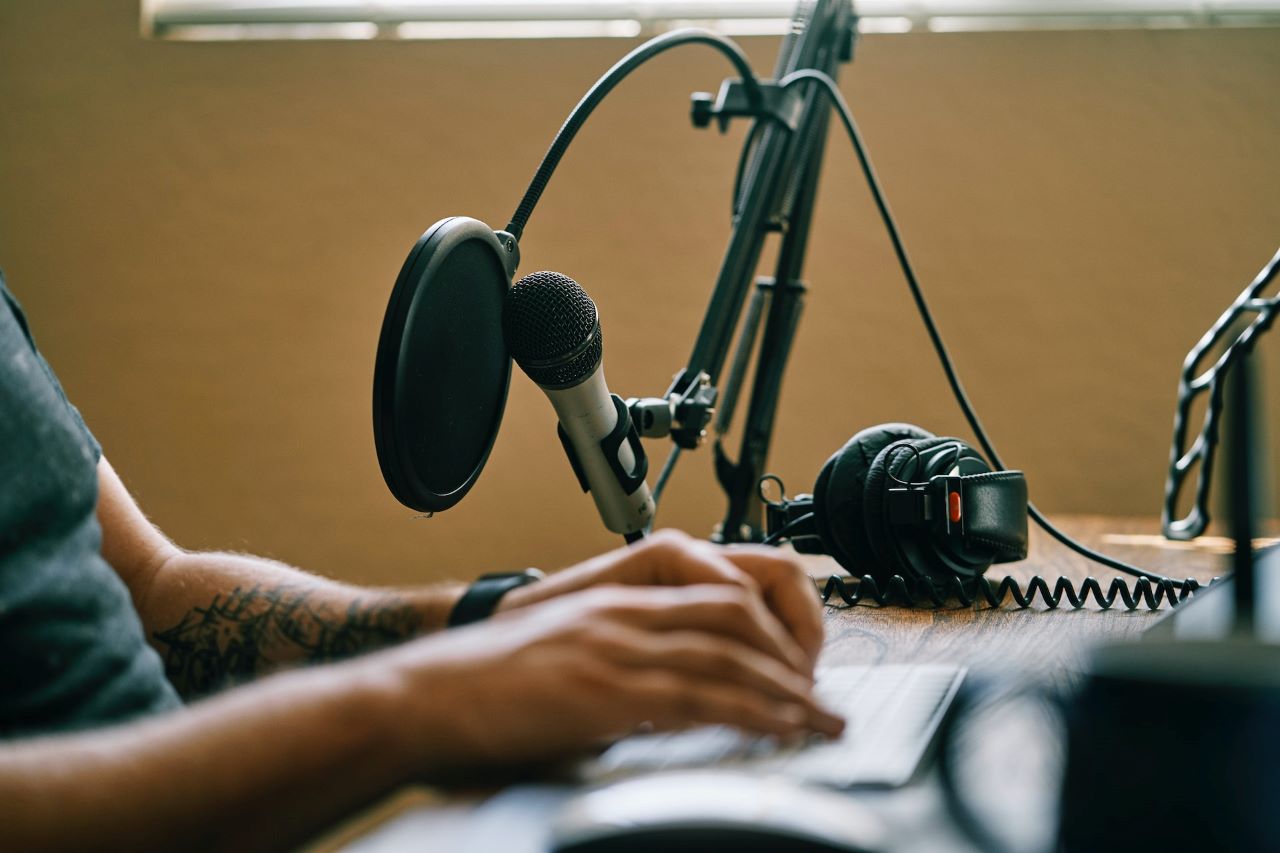When it comes to podcasting, recording or broadcasting, the clarity of your audio can make or break the listener’s experience. Often overlooked, the placement of your microphone, especially when using a boom arm, plays a pivotal role in capturing pristine sound. This article delves into the nuances of boom arm positioning, a seemingly simple yet crucial aspect of the audio setup.
So if you’re a budding podcaster, a professional voice-over artist, or someone stepping into the realm of audio production, understanding the art of microphone placement is essential. We’ll explore how slight adjustments can significantly enhance sound quality, reduce unwanted noise, and ensure a comfortable setup for prolonged sessions.
Related: Best Microphone Arms
Contents
The Importance Of Proper Boom Arm Placement
It’s not just about having a high-quality microphone; where and how you position it is equally vital. The right placement of your mic stand ensures that your microphone captures sound optimally, reducing the need for extensive post-production adjustments.
It also helps in minimizing background noise and interference, which is crucial for producing clear, professional-quality audio. In this section, we’ll explore various aspects of boom arm placement and how they impact your recording experience.
Impact On Sound Quality
The primary goal of any audio recording setup is to achieve the best possible sound quality. The position of your microphone directly influences how your voice or instrument is captured. A well-placed boom arm ensures that the microphone is at the right distance and angle from the sound source, enabling it to pick up the intended audio clearly while minimizing background noise.
Ergonomics And Comfort

Image by DCStudio on Freepik
While sound quality is paramount, the comfort of the person using the microphone is equally important. An ergonomically positioned mic arm can significantly reduce strain during long recording sessions.
Reducing Environmental Interference
One of the less obvious yet critical aspects of boom arm placement is its role in reducing environmental interference. The environment in which you record can have a significant impact on the audio quality. Factors such as room echo, external noise, and even the hum of electronic devices can intrude into your recording. Strategic placement of your boom arm can help mitigate these issues.
Versatility For Different Recording Situations
The versatility of a boom arm is a boon for those who record in various scenarios. Whether you’re hosting a podcast, recording vocals, or capturing instruments, each situation demands a unique microphone placement. A boom arm’s flexibility allows for easy adjustments to suit these different needs.
Longevity And Care Of Equipment
Proper boom arm and microphone placement isn’t just about achieving the best audio quality; it’s also about taking care of your equipment. Incorrect positioning can lead to undue stress on the boom arm joints and microphone cables, potentially shortening their lifespan.
Setting Up Your Boom Arm
Setting up your boom arm correctly is a fundamental step in achieving the best possible audio quality. This process involves more than just attaching the arm to your desk and hanging a microphone from it. It requires careful consideration of location, mounting, and adjustments related to the mic placement to suit your specific recording needs.
Step One: Choosing The Right Location
The first step in setting up your boom arm is choosing the right location. This decision is crucial as it affects not only sound quality but also your comfort during recording sessions. Look for a spot that is both convenient and conducive to good audio capture. It should be away from noise sources like windows, doors, and noisy electronics.
Consider the acoustics of the room; avoid areas with too much echo or reverb. The location should also allow you to sit or stand comfortably without straining to reach the microphone. This step sets the foundation for a successful recording setup.
Step Two: Mounting And Securing The Boom Arm

Image by serhii_bobyk on Freepik
Once you’ve identified the ideal location, the next step is to mount your boom arm securely. Most boom arms come with a clamp or mount that can be attached to a desk or table. Ensure that the surface you choose is stable and sturdy enough to support the weight of the boom arm and the microphone.
When attaching the clamp, make sure it’s tightened sufficiently to prevent any wobbling or movement, but be careful not to over-tighten as this can damage your furniture. If your boom arm has a suspension system, ensure it’s properly balanced to avoid strain on the arm and to facilitate easy movement.
Step Three: Adjusting The Arm’s Reach And Angle
After mounting the boom arm, the next step is to adjust its reach and angle. This is where you tailor the setup to your specific needs. Extend the arm and position it so that the microphone can be placed comfortably close to your mouth without obstructing your view or movements.
The angle of the arm should allow the microphone to be positioned either directly in front of you or slightly off-axis, depending on your preference and the type of recording. Remember, the goal is to find a balance between comfort and optimal sound capture.
Step Four: Attaching And Positioning The Microphone
With the boom arm in place, it’s time to attach the microphone. If your microphone has a shock mount, attach it to the end of the boom arm first, then secure the microphone within the shock mount. This helps to reduce handling noise and vibrations.
Position the microphone so that it faces the sound source (usually your mouth) at the correct distance – typically about four to six inches away. Adjust the angle to avoid plosives and to capture the best sound quality.
Step Five: Cable Management
The final step in setting up your boom arm is proper cable management. This step is crucial for both safety and functionality. Run the microphone cable along the boom arm, using cable ties or clips to secure it in place.
This prevents the cable from dangling and getting tangled or pulled, which could damage both the cable and the microphone. Ensure there’s enough slack for you to move freely but not so much that it becomes unruly. Good cable management keeps your workspace neat and ensures the longevity of your equipment.
Adjusting And Positioning The Boom Arm

Photo by ConvertKit on Unsplash
Mastering the art of adjusting and positioning your boom arm is essential for capturing high-quality audio. This process goes beyond mere setup; it’s about fine-tuning the placement to suit specific recording needs. Whether you’re dealing with basic setups or more complex scenarios, understanding how to manipulate your boom arm’s position can drastically improve your audio output.
In this section, we’ll explore various techniques and strategies, from basic positioning to advanced adjustments, ensuring your recordings are clear, crisp, and professional.
Basic Positioning Techniques
Before diving into complex strategies, mastering basic positioning techniques is crucial. These foundational methods form the bedrock of effective microphone placement. Let’s explore several key techniques:
Straight vs. Angled Placement
The most straightforward technique involves deciding between a straight or angled placement of the boom arm. A straight placement, where the arm extends directly towards you, is ideal for speaking directly into the microphone. Angled placement, where the microphone arm, the microphone and the pop filter are positioned at an angle, can help reduce plosives and mouth noises.
Height Adjustment
Adjusting the height of the boom arm is essential for comfort and sound quality. The microphone should be positioned at a height where you can speak naturally without bending or straining your neck. This also helps in capturing the natural tone of your voice.
Distance From The Sound Source
The distance between the microphone and the sound source (usually your mouth) is critical. A general rule is to keep it about four to six inches away, especially in case of condenser microphones. This distance helps in capturing a clear, full-bodied sound while minimizing breathing sounds and plosives.
Advanced Positioning Strategies

Image by Freepik
For those looking to elevate their audio quality further, advanced positioning strategies can be employed. These techniques require a bit more finesse and understanding of acoustics:
- Off-Axis Positioning: This involves positioning the microphone slightly off to the side of the sound source rather than directly in front. It helps in capturing a more natural sound and reduces the intensity of plosives and sibilance.
- Utilizing the Proximity Effect: Understanding and using the proximity effect can enhance your crystal-clear audio. By moving closer to a directional microphone, you can boost the bass frequencies of your voice, giving it a fuller and warmer tone. This technique is great for voice-over work or when a more intimate sound is desired.
- Counteracting Room Acoustics: If you’re in a room with less-than-ideal acoustics, positioning the boom arm on your desk setup to minimize the pickup of echoes and reverberations can be crucial. This might involve experimenting with different angles and distances from walls and hard surfaces.
Conclusion
Mastering the art of boom arm placement is a journey that significantly enhances the quality of your audio recordings. Throughout this article, we’ve explored the multifaceted aspects of microphone positioning, starting from the importance of proper boom arm placement and its impact on sound quality, ergonomics, and environmental interference. We delved into the practical steps of setting up your boom arm, covering everything from choosing the right location to managing cables effectively.
We also navigated through the nuances of adjusting and positioning the boom arm, discussing basic techniques for beginners and advanced strategies for more experienced users. Adapting to different recording environments and handling collaborative settings were also key topics, ensuring that you’re well-equipped to handle a variety of recording scenarios.
Remember, the goal is not just to capture sound but to do so in a way that is comfortable, efficient, and conducive to producing the best possible audio quality. Whether you’re a podcaster, a musician, or a professional voice-over artist, the insights and techniques shared here about the placement of your microphone stand will help you achieve a setup that meets both your audio and ergonomic needs.
With practice and experimentation, you’ll find the perfect balance that works for your unique situation, leading to recordings that are not only clear and crisp but also a true representation of your intended sound.
Related: Best Boom Arm For Blue Yeti